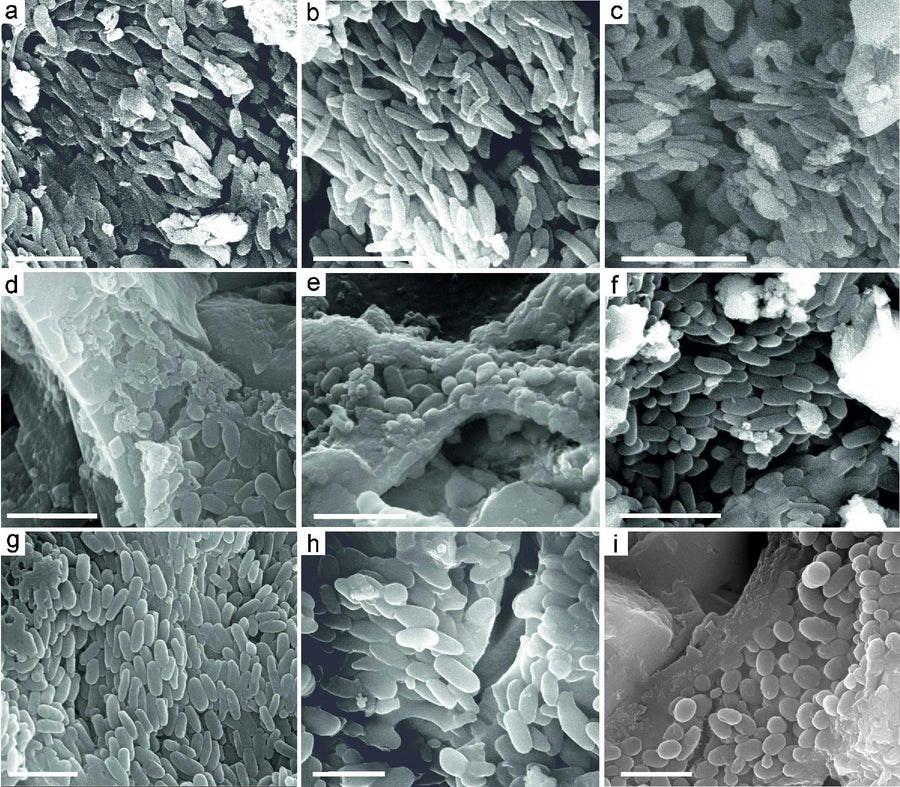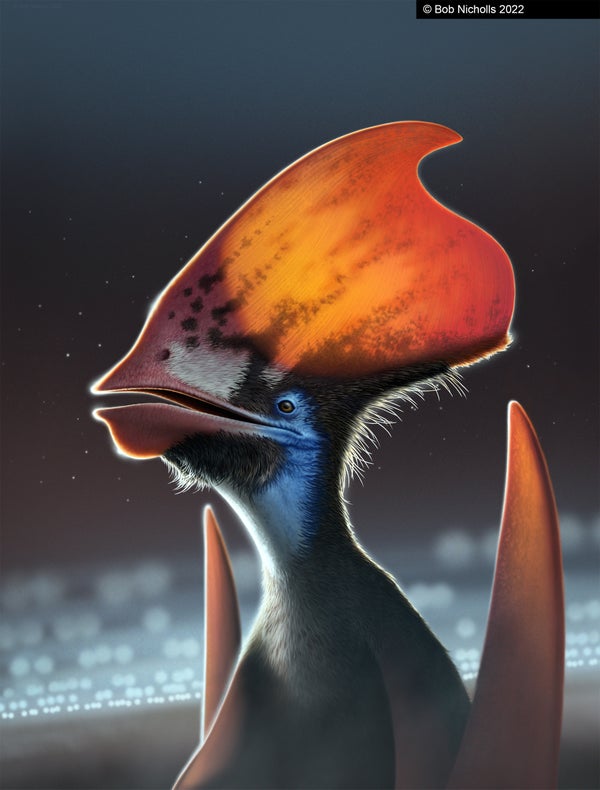Long before the first birds flapped and fluttered, pterosaurs took to the skies. These leathery-winged reptiles, their bodies coated with wispy filaments paleontologists call pycnofibers, were the first vertebrates to truly fly. Now experts are beginning to think pterosaurs and birds had more in common than previously assumed: An exquisitely preserved fossil from Brazil not only hints that pterosaurs’ peculiar filaments may have been true feathers but also suggests that this plumage could possibly have been as riotously colored as that of any modern toucan or tanager.
The fossil, described on Wednesday in a new study in Nature, is a pterosaur called Tupandactylus imperator that was found in the Early Cretaceous limestone of Brazil’s Crato Formation. “What is remarkable about this specimen—and very obvious when you look at it—is the fact that it preserves extensive soft tissues,” says study co-author Maria McNamara, a paleobiologist at University College Cork in Ireland.
This specimen has a vague and complicated history. It is unclear who found the fossil or when they did so, but it wound up in the hands of a private collector and was later given to the Royal Belgian Institute of Natural Sciences. At that point, paleontologist Edio-Ernst Kischlat “was then contacted to find an official agreement with Brazilian authorities and the Embassy of Brazil in Brussels,” says the new study’s lead author Aude Cincotta, now at the Belgian institute.In October 2021 the institute signed a deal with the Brazilian embassy to repatriate the fossil, and it arrived at Rio de Janeiro’s Museum of Earth Sciences in February of this year.
On supporting science journalism
If you're enjoying this article, consider supporting our award-winning journalism by subscribing. By purchasing a subscription you are helping to ensure the future of impactful stories about the discoveries and ideas shaping our world today.
The unauthorized excavation of fossils in Brazil and the private ownership of such fossils have been illegal since 1942, and the Crato Formation was not mined until sometime after that year, says paleontology Ph.D. student Rodrigo Pêgas of the Federal University of ABC in Brazil, who was not involved with the new study. Similar issues have recently arisen in the paleontology community over other fossils: a 2020 study of a feathered dinosaur from the same formation was retracted after it came to light that the specimen involved was possibly smuggled out of Brazil. The authors of the new Tupandactylus study noted the fossil’s unclear background in a reporting summary for the paper.

Scanning electron micrographs of melanosomes in the soft tissues of the Tupandactylus imperator fossil. Credit: “Pterosaur Melanosomes Support Signalling Functions for Early Feathers,” by Aude Cincotta et al., in Nature. Published online April 20, 2022
Whatever the story behind the pterosaur fossil, leaving private hands to a secure place in a museum allowed it to finally be described. Initially, McNamara says, she and her colleagues studied the specimen with an eye toward identifying the details of its remarkably clear soft tissues. The researchers were not necessarily looking for clues to color, she notes—but she says they were “delighted” to find such evidence in the form of microscopic structures called melanosomes.
Since 2008 paleontologists have been turning to melanosomes to study the color of fossil dinosaurs, pterosaurs and other organisms. Melanosomes’ shape and density, as well as their distribution in skin, feathers and other tissues, help create what biologists know as structural colors: hues that range from rust red to oil-slick iridescent and that are created by the way light interacts with the feathers. (These structures can only provide a partial picture of an animal’s coloration, however, because many shades are created chemically.) McNamara and her co-authors found different melanosome shapes in Tupandactylus’s skin and in two types of the fluffy, featherlike filament structures along its skull, implying the colors in each would have been different from one another.
Paleontologists have recently questioned earlier hypotheses about which melanosome shapes create which particular shades. “In the pterosaur we studied, we didn’t attempt to infer the color produced,” McNamara says. Still, she notes, the melanosome shapes are different in the two different filament types—whether they are interpreted as pycnofibers or feathers—which indicates varied hues, with the branched filaments likely being lighter in color than the unbranched ones.
Though this area of paleontology is still new, previous pterosaur studies only found homogenous melanosome shapes in their tissues. This hints that those pterosaurs were either uniformly colored or relied on chemically created coloration for additional shades. The finding that Tupandactylus had different melanosome shapes among skin and filament typesis evidence that this pterosaur wore a palette of different colors by the Early Cretaceous, a trait shared by birds and other feathered dinosaurs. As they evolved, “pterosaurs had the ability to tune the color of their feathers by changing the shape of their melanosomes, just as in theropod dinosaurs and birds,” McNamara says.
Coloration is extremely important to animals, playing roles that range from camouflage to communication. McNamara and her co-authors propose that the different shades in the Cretaceous pterosaur had a role in social signaling, which can telegraph an animal’s health, age, sex, readiness to mate and other vital aspects of their biology. “If some pterosaurs did have complex and colorful patterns, then, yes, this is strong evidence that it played a role in social signaling,” Pêgas says, adding that they look forward to other researchers testing and confirming the results of the new paper.
There has also been some academic debate about whether pterosaur fuzz represents true feathers or featherlike pycnofibers. McNamara, for her part, says there is no doubt that these filaments in Tupandactylus and other pterosaurs were feathers. The main evidence she and her co-authors cite is that the fossil from Brazil has both simple filaments and feathery structures that are branched along their length, a feature only seen in dinosaur feathers.
If both pterosaurs and dinosaurs had feathers, and if those feathers had variable shades for visual communication, then either those traits evolved independently in each branch or they go back to the common ancestors of both groups—reptiles that lived early in the Triassic Period more than 243 million years ago. “We feel that the common structure in dinosaurs and pterosaurs reflects shared ancestry,” McNamara says. Likewise, the findings add support to the hypothesis that some kind of feather or feather precursor was present among these Triassic reptiles, hinting that many more pterosaurs and dinosaurs wore feathery body coverings than paleontologists expected. Pêgas points out that no skin impressions, feathers or other body coverings from Triassic dinosaurs and pterosaurs have yet been found to test this hypothesis. Paleontologists are only just beginning to uncover the deep history of colorful fluff and fuzz, a line of inquiry that will have experts digging into the earliest days of the Age of Reptiles.
